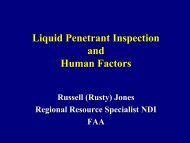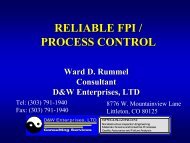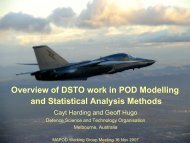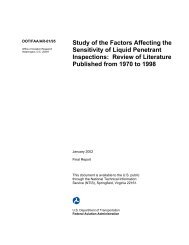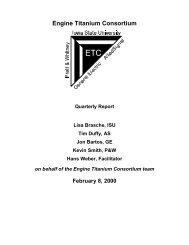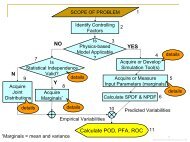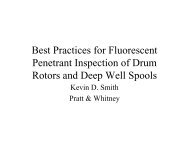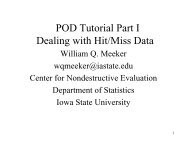Engine Titanium Consortium - Center for Nondestructive Evaluation ...
Engine Titanium Consortium - Center for Nondestructive Evaluation ...
Engine Titanium Consortium - Center for Nondestructive Evaluation ...
Create successful ePaper yourself
Turn your PDF publications into a flip-book with our unique Google optimized e-Paper software.
naturally occurring flaws in <strong>for</strong>gings. It is recognized that this morphology will be somewhat<br />
different from that in billets due to the de<strong>for</strong>mations that occur in the <strong>for</strong>ging process. Close<br />
contacts will be maintained with the TRMD program to obtain the necessary morphology<br />
in<strong>for</strong>mation.<br />
Development of the Capability to Make Predictions of the Local POD in Final Forging Shapes:<br />
Because of the complexity of the geometry of final part shape and of the effects of anisotropy<br />
associated with flow lines, the POD will depend strongly on position in final <strong>for</strong>ging shapes. The<br />
new methodology is designed to take these effects into account, and this capability will be<br />
developed and applied. The essential steps that are required will be determinating, on a<br />
point-by-point basis, the following:<br />
• Effect of <strong>for</strong>ged material on the flaw response and noise distributions, building on the results of<br />
the sonic-shaped studies<br />
• Effect of surface curvature and other geometrical parameters on the beam shape and there by<br />
on the flaw response and noise distributions<br />
In parallel, an implementation plan <strong>for</strong> including these point-by-point variations in the methodology<br />
will be developed, so that the result can be efficiently integrated with the life prediction code,<br />
DARWIN.<br />
Experimental validation will then be undertaken. The ultrasonic response model will be used to<br />
predict the signal response from flaws which are insonified through representative surface<br />
geometries using the samples being developed in Task 1.3.1. Samples will be designed in<br />
cooperation with 1.3.1 to evaluate the full range of surface curvatures typical in final and sonic<br />
shape <strong>for</strong>gings. Consideration will also be given to evaluation beyond typical curvatures to<br />
determine the limits of the model applicability. The flaw response model will be verified by scanning<br />
these specimens and comparing these observations to the model predictions. Checks on the<br />
resulting POD predictions will be made <strong>for</strong> certain testing situations <strong>for</strong> which POD curves have<br />
been estimated by other means (e.g., the ahat vs. a and the R e methods). Upon completion of<br />
these tests, an updated version of the methodology will be prepared.<br />
Improvements/Transfer of the POD/PFA Methodology Software to OEMs: For the new<br />
methodology to have full impact on damage tolerant design and management of rotating<br />
components of aircraft engines, it is necessary that the tools, i.e., software <strong>for</strong> implementing the<br />
methodology, the associated modules <strong>for</strong> predicting flaw and noise response as influenced by<br />
anisotropy and geometry, and materials characterization procedures to efficiently use them, be in a<br />
<strong>for</strong>m that can be readily used by the OEMs. These tools will be developed, incorporating the results<br />
of the previously described major work elements. Included will be the methodology software, flaw<br />
and noise response modeling modules (as influenced by anisotropy and part geometry), and<br />
characterization procedures to provide the necessary inputs. As in 3.1.1, numerical approximations<br />
to the predictions of the ultrasonic response models will be developed which are suitable <strong>for</strong> being<br />
called by the methodology to speed the calculation process to a rate which will be convenient <strong>for</strong> a<br />
user operating in an interactive mode. Also building on the experiences gained in the Task 3.1.1,<br />
the flaw response models and noise models will be designed to incorporate the effects of<br />
microstructure on beam profile, and hence, on the distribution of flaw response, the effects of tight<br />
Quarterly Report – January 1, 2002 –March 31, 2002<br />
print date/time: 6/6/2002 - 8:39 AM – Page 100



